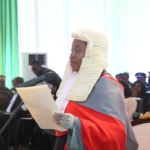General
Supreme Court indefinitely adjourns hearing on suit challenging processes to remove Chief Justice
The Supreme Court has adjourned indefinitely the hearing of a suit challenging the processes being used to potentially remove Chief Justice Gertrude Torkornoo from office. The case, filed by Old Tafo MP Vincent Ekow Assafuah, was scheduled to be heard on Wednesday, April 9. However, the court adj...
MyJoyOnline
published: Apr 09, 2025


The Supreme Court has adjourned indefinitely the hearing of a suit challenging the processes being used to potentially remove Chief Justice Gertrude Torkornoo from office.
The case, filed by Old Tafo MP Vincent Ekow Assafuah, was scheduled to be heard on Wednesday, April 9.
However, the court adjourned the case on the basis that some 50 State Attorneys were unavailable because they were attending a training to effectively represent the interests of the State at the ECOWAS Court.
It is not certain yet when the hearing will begin since a new date was not announced.
The suit challenges the constitutional procedure followed by President John Mahama after receiving three petitions calling for the Chief Justice’s removal.
Mr Assafuah is seeking a declaration that the Chief Justice must be allowed to respond to the allegations before the President could initiate consultations with the Council of State under Article 146(6) of the 1992 Constitution.
Mr Assafuah, represented by former Attorney-General Godfred Dame, argues that failing to notify the Chief Justice beforehand violates her right to a fair hearing and undermines judicial independence.
There’s also a similar suit at the Supreme Court by a private citizen.
The Supreme Court was expected to determine whether the President’s actions comply with the constitutional provisions governing the removal of a sitting Chief Justice.
Meanwhile, the Chief Justice has officially responded to the petitions after the President subsequently sought her preliminary response by giving her ten days to do so.
Joy News sources say the Chief Justice has responded accordingly to the petition, and the next steps in the process are expected to continue.
Legal experts say the case before the Supreme Court may now be moot following the turn of events that followed after it wss filed.
Article 146 – Removal of Justices of Superior Courts And Chairmen Of Regional Tribunals
1) A Justice of the Superior Court or a Chairman of a Regional Tribunal shall not be removed from office except for stated misbehaviour or incompetence or on the ground of inability to perform the functions of his office arising from infirmity of Body or mind.
(2) A Justice of the Superior Court of Judicature or a Chairman of a Regional Tribunal may only be removed in accordance with the procedure specified in this article.
(3) If the President receives a petition for the removal of a Justice of a Superior Court other than the Chief Justice or for the removal of the Chairman of a Regional Tribunal, he shall refer the petition to the Chief Justice, who shall determine whether there is a prima facie case.
(4) Where the Chief Justice decides that there is a prima facie case, he shall set up a committee consisting of three Justices of the Superior Courts or Chairmen of the Regional Tribunals or both, appointed by the Judicial Council and two other persons who are not members of the Council of State, nor members of Parliament, nor lawyers, and who shall be appointed by the Chief Justice on the advice of the Council of State.
(5) The committee appointed under clause (4) of this article shall investigate the complaint and shall make its recommendations to the Chief Justice, who shall forward them to the President.
(6) Where the petition is for the removal of the Chief Justice, the President shall, acting in consultation with the Council of State, appoint a committee consisting of two Justices of the Supreme Court, one of whom shall be appointed chairman by the President, and three other persons who are not members of the Council of State, nor members of Parliament, nor lawyers.
(7) The committee appointed under clause (6) of this article shall inquire into the petition and recommend to the President whether the Chief Justice ought to be removed from office.
(8) All proceedings under this article shall be held in camera, and the Justice or Chairman against whom the petition is made is entitled to be heard in his defence by himself or by a lawyer or other expert of his choice.
(9) The President shall, in each case, act in accordance with the recommendations of the committee.
(10) Where a petition has been referred to a committee under this article, the President may-
(a) In the case of the Chief Justice, acting in accordance with the advice of the Council of State, by warrant signed by him, suspend the Chief Justice;
(b) In the case of any other Justice of a Superior Court or of a Chairman of a Regional Tribunal, acting in accordance with the advice of the Judicial Council, suspend that Justice or that Chairman of a Regional Tribunal.
(11) The President may, at any time, revoke a suspension under this article.
Read More